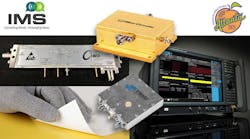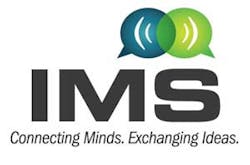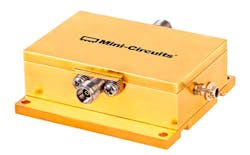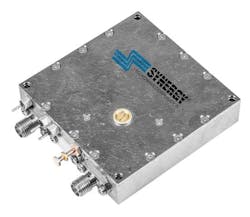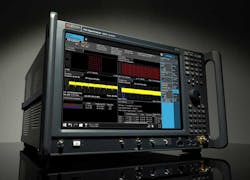IMS 2021 Prepares for mmWave Applications
Download this article in PDF format.
Check out our full coverage of IMS 2021.
What you'll learn:
- How does IMS 2021 become a two-fold event this year—live and virtual?
- The surge in mmWave-related advances.
- What products are already making news preceding the symposium?
For the RF/microwave industry, this event is one not to forget, the largest placeholder on the calendar. In years past, the IEEE International Microwave Symposium (IMS) has been the technical conference and exhibition that brought the industry together for a week. But this isn’t just any year—the pandemic caused by the COVID-19 coronavirus has forced most industries to be cautious how they do business.
However, the RF/microwave industry has always adapted to change and the way the internet is now used as a key channel of communications. The industry will support a traditional version of “Microwave Week” at the face-to-face version of the IEEE IMS 2021 Conference and Exhibition scheduled for June 7-10, 2021 at the Georgia World Congress in Atlanta, Ga. There’s also an online version taking place June 20-25, 2021, wherever they have internet access.
Many companies have expressed great enthusiasm at the opportunities to meet face-to-face with customers at their exhibitor booths. But, as with many public events, attendance has been hindered by the threat of the COVID-19 virus, often reaching only 20% of expected totals.
In the hopes of meeting customers in Atlanta, the RF/microwave industry has contributed to a strong IMS show lineup of more than 300 exhibitors for the face-to-face and virtual versions of the exhibition. As usual, there’s a diversified assortment of technologies and products from components, circuit materials, and multifunction assemblies through design software and test equipment.
The exhibition has always represented almost a week of constant activity, meeting new clients, and catching up with existing customers and friends. Visitors have a chance to connect with their current suppliers and find new sources of products for aerospace, commercial, defense, industrial, and medical marketplaces. In addition to the exhibition, the IMS 2021 features a strong conference of RF/microwave engineering speakers with technical lectures, white papers, and workshops.
Two Conferences in One
The first day (June 7) of the face-to-face IMS 2021 technical conference opens with a pair of plenary talks. Suresh Venkatarayalu, Chief Technology Officer of Honeywell, will welcome guests to the IMS 2021 with a special IMS keynote lecture. That same day, Dr. Ahmad Bahai, Chief Technology Officer and Senior Vice-President of Texas Instruments, will present a keynote talk introducing the 2021 IEEE Radio Frequency Integrated Circuit Symposium (RFIC 2021), co-located with the IMS 2021 technical conference in the nearby Omni Hotel.
For those interested and involved in high-frequency, high-speed measurements, the technical portion of the face-to-face conference closes with a long-running tradition: the 97th meeting of the Automatic RF Techniques Group (ARFTG) Thursday, June 10, also in the Omni Hotel. This session will have a strong focus on mmWave measurements.
Those traveling to Atlanta can enjoy a strong primary technical conference as part of IMS 2021, with technical sessions on transmitters and power amplifiers (PAs); RF through millimeter-wave (mmWave) filtering; advances in materials, including frequency-selective materials and metasurfaces; circuit materials for mmWave frequencies; physical-layer security, including radio channel modeling; antenna arrays for wireless applications; conserving energy in low-power circuits; and advanced waveguide designs.
Later in the month, from June 20-25, the virtual technical conference features an intriguing collection of online presentations. It may not offer the same opportunities for interaction and feedback as the live event, but, if anything, covers a more widely diversified list of topics, from filter fundamentals to biomedical design issues.
The first day of technical sessions at the virtual conference (June 22) offers presentations on advanced technologies for transceivers, machine learning (ML) for computer-aided-design (CAD) tools, electromagnetic (EM) fields for security applications, and acoustic filters for communications. The following day (June 23) continues the strong focus on mmWave design, with online presentations about wireless sensor systems, frequency conversion circuits, waveguide and composite structures, instruments for biomedical measurements, and mmWave PAs. The final day of sessions (June 24) covers advances in radar systems, mmWave circuits and components, beamforming array antennas, and low-noise amplifiers (LNAs).
Exhibitor Showcase
The areas of interest in the face-to-face and virtual technical conferences are mirrored by the variety of products on display during both versions of the IMS 2021 exhibition. Exhibitors scheduled for the face-to-face and virtual exhibitions comprise a representative sample of the RF/microwave industry, providing products from as basic as inductors to as elaborate as “smart” signal analyzers.
With the widespread adoption of mmWave devices and modules into automotive electronic systems such as advanced driver-assistance systems (ADAS) and 5G cellular wireless networks, both show floors are expected to have “higher-frequency” feels to them at many of the booths. Attention paid to frequencies of 24 GHz and higher is expected to impact most of the product areas at the exhibitions, including active and passive components, design software, materials, semiconductors, and test equipment.
Long-time amplifier supplier Empower RF Systems Inc. (booth 1225) will show visitors a sampling of its high-power amplifiers (HPAs) for communications, military, radar, satcom, and test-and-measurement applications. Some of these are solid-state replacements for the oversized vacuum-tube amplifiers powering military jammers and radar systems, such as the model 2210 HPA. It provides 12-kW saturated pulsed output power from 150 to 450 MHz in a rack-mount enclosure. The 2210 consists of two amplifiers based on silicon (Si) laterally diffused metal-oxide-semiconductor (LDMOS) transistors teamed with a power converter and a power-control and combining assembly. Empower is expected to have many smaller amplifiers at its booth, with less output power at higher frequencies.
On a smaller scale, Ciao Wireless (booth 1812) will show broadband, high-gain, and low-noise amplifiers (LNAs) (Fig. 1), with models covering total bandwidth of 1 to 40 GHz with flat gain levels of 20, 25, 30, or 35 dB and noise figure as low as 4 to 5 dB through 40 GHz. Well-suited for commercial and military applications, the coaxial amplifiers are available with integral power detectors, voltage-variable attenuators, and output couplers covering the full frequency range and as much as +20-dBm output power at 1-dB gain compression.
Mini-Circuits (booth 1921) will greet visitors in Atlanta with a sampling of its diversified product portfolio, including its model ZVA-24443G1 mmWave LNA, with typical noise figure of just 1.7 dB across its wide frequency range of 24.0 to 43.5 GHz (Fig. 2). Designed for a single supply voltage of +9 to +15 V dc, the coaxial amplifier delivers typical output power of +20 dBm across the full bandwidth and features integrated overvoltage and reverse-voltage protection.
To satisfy a growing need for frequency conversion at mmWave frequencies, Mini-Circuits will also highlight its model MDB653H-D+ double-balanced mixer die. Well-suited to fit in the tightest PCBs, such as in SWaP applications, the frequency mixer has an RF frequency range of 20 to 65 GHz, mixing with local-oscillator (LO) signals over the same frequency range to produce intermediate-frequency (IF) signals from dc to 20 GHz for signal processing. It can also be used in the reverse direction for frequency upconversion, transforming IF signals to mmWave signals from 20 to 65 GHz at its RF port.
For those interested in some of the smallest, highest-power amplifiers at X-band frequencies but not inclined to travel, Wolfspeed/Cree (virtual booth VO3053) will feature its gallium-nitride-on-silicon-carbide (GaN-on-SiC) monolithic microwave integrated-circuit (MMIC) amplifiers for pulsed and CW applications. Designed for +28-V dc supplies, the tiny amplifiers fit into surface-mount-technology (SMT) packages. For example, the model CMPA901A0205 provides typical gain of 31 dB with 20-W saturated output power and 45% power added efficiency (PAE) from 9 to 10 GHz, while model CMPA80180305 offers 40 W saturated output power with 20-dB gain and 40% PAE from 7.9 to 11.0 GHz.
Also at the virtual exhibition, Herotek (virtual booth VO3220), in keeping with the growing interest in mmWave frequencies, will highlight its model A2640205010A LNA. It maintains 20-dB small-signal gain with typical gain flatness within ±2.5 dB from 26 to 40 GHz and maximum noise figure of 5 dB across the full frequency range. Suitable for receivers and test equipment, the amplifier also can deliver +10-dBm output power at 1-dB compression.
For signal generation, Synergy Microwave Corp. (virtual booth VO3025) will show visitors its KSFLOD series of phase-locked dielectric resonator oscillators (DROs), with fundamental-frequency outputs starting at 6 GHz through 15 GHz, and as high as 45 GHz when tripled. With low phase noise and spurious outputs, the compact coaxial DROs (Fig. 3) are well-equipped to provide LO and other signals in 5G, radar, and test systems.
Passives
Specifiers of passive components will also find a wide variety of components at both versions of the IEEE IMS 2021, from the most basic to the most elaborate. For those in need of inductors and transformers, Coilcraft (virtual booth VO3340) will show examples of its extensive lines of RF and power magnetic components, including inductors and transformers for commercial, automotive, military, industrial, and space applications.
The company has developed AEC-Q200-qualified inductors for the growing number of automotive electronic applications, such as ADAS-based LiDAR and radar systems, tire-pressure monitoring systems (TPMS), and electric power-steering (EPS) circuits. The components are designed for operating temperatures from −140 to +125°C.
Ironwood Electronics (booth 2140) will show Atlanta visitors versions of its high-speed, high-frequency sockets well-suited for interconnections through 110 GHz. Available in standard and custom versions to replace obsolete interconnections and packaging, the sockets are designed for operating lifetimes as long as 500,000 insertions. The company will also show its Giga-snaP BGA SMT adapters for reliable interconnections to BGA SMT pads. The adapters remain attached through many solder cycles, with a fraction of the insertion force of other SMT adapters.
Mini-Circuits will be in Atlanta and at the virtual exhibition with its own collection of passive components, including miniature low-temperature cofired-ceramic (LTCC) filters, such as lowpass model LFCN-3052+. Designed to reject mmWave signals to 50 GHz, the tiny filter measures just 3.2 × 1.6 mm with low insertion loss of typically 1.2 dB across a wide passband of dc to 30.5 GHz. It delivers as much as 40-dB rejection from 41.5 to 47.0 GHz and at least 26-dB rejection across a stopband of 36.5 to 50.0 GHz.
Also on tap is its model RCDAT-30G-30 programmable attenuator, which can be simply controlled by USB or Ethernet connection to a computer. With a frequency range of 100 MHz to 30 GHz, it adjusts attenuation from 0 to 30 dB in 0.5-dB steps.
Antennas are usually passive devices, but more and more phased-array antennas with active beamforming are being considered at mmWave frequencies. For those wishing to get a “jumpstart” on a mmWave phased-array antenna, Anokiwave (virtual booth VO3042) will show virtual exhibition visitors its scalable active antenna kits. The kits feature phased-array antennas on PCBs, designed and constructed with the company’s innovative beamforming and steering ICs. Antenna kits are available for different 5G NR frequency bands, such as the 28-GHz n257 and n261 bands. The antennas are ready for transmit and receive actions, as well as for testing with instruments such as a spectrum analyzer and test antenna.
Creating Circuits
Basic materials are a starting point for most electronic designs, whether they’re semiconductors, packages, or circuits, and the growing importance of mmWave frequencies has made an impact on materials development over the last few years.
On the Atlanta exhibition floor, Rogers Corp. (booth 1841) will display examples of its growing lines of materials to constructed PCBs from RF through mmWave frequencies, including its RO4835T laminates (Fig. 4). Designed to work with RO4835 laminates as thin inner layers for multilayer PCBs, they provide designers some control of the overall thickness of a multilayer PCB—even when stacking many circuit layers into a densely integrated design—whether for commercial, industrial, medical, or military electronic designs.
With a dielectric constant (Dk) of 3.3, RO4835T laminates can be fabricated with the same processes used for FR-4-based PCBs. The laminates feature low loss, with dissipation factor of 0.0030 to 0.0036 depending on thickness. Thermal properties are excellent, too, with coefficient of thermal expansion (CTE) of 17 ppm/°C or less, again depending on thickness.
At the virtual exhibition, Isola (virtual booth VO2949) will show its Tachyon 100G circuit materials for mmWave applications to 100 GHz and high-speed digital circuits to 100 Gb/s. Also available in a wide range of thicknesses for construction of compact multilayer circuits, the materials exhibit low CTE values and excellent stability for operating temperatures from −55 to +125°C. Its spread-glass construction contributes to low jitter and reduced rise/fall times in digital circuits and its smooth copper helps minimize conductor losses.
Testing the Limits
Keysight Technologies recently released a handy 22-page application note on using different signal analyzers, titled “Signal Analysis Measurement Fundamentals.” It provides guidance on improving the measurement accuracy of a test setup and how different settings, such as resolution bandwidth, will affect measurement speed.
In Atlanta, Keysight (booth 1321) will bring visitors up to speed on signal analysis, with several high-performance instruments on hand. The model N9042B UXA signal analyzer (Fig. 5) features a phenomenal analysis range of 2 Hz to 110 GHz and wide dynamic range. Ideal for finding and analyzing signals in 77-GHz automotive radars and short-range mmWave links in 5G wireless networks, the signal analyzer can sweep across its full frequency range with analysis bandwidth as wide as 11 GHz, to search for and find expected as well as unknown signals.
Keysight will also display its FieldFox portable microwave analyzers in Atlanta. The compact, waterproof instrument brings signal analysis to the field, in a package weighing less than 8 lbs. Models are now available with top frequencies to 54 GHz, such as the 52-GHz model N9952B with maximum analysis bandwidth of 120 MHz and dynamic range as wide as 105 dB. The portable signal analyzers are supported by test software packages such as the firm’s PathWave vector-signal-analysis (VSA) software to analyze high-frequency signals with complex modulation formats, such as quadrature amplitude modulation (QAM).
Rohde & Schwarz (booth 1821) will be in Atlanta with an assortment of high-performance RF/microwave test equipment, including its R&S ZVA vector network analyzers (VNAs). Versions are available from 10 MHz to 26.5, 43.5, 50, and 67 GHz to characterize active and passive components for many emerging mmWave applications. The hybrid test instrument/computer and its advanced user interface has a front panel with a 12.1-in. touchscreen display that can be divided into two independent display screens for detailed analysis and control.
As part of the virtual exhibition, FormFactor (virtual booth VO3245) will show how it applies microelectromechanical-systems (MEMS) technology to the fabrication of its fine-pitch probe cards for semiconductor testing. As an example, its Altius vertical MEMS probe card enables high-speed, high-frequency testing of high-density interconnections on semiconductor packaging. Anritsu (virtual booth VO3353) will also assist mmWave testers, displaying its ME7838A4 VectorStar series of microwave/mmWave four-port VNAs, with models from 70 kHz to 110, 125, 145, and 150 GHz.
This is a small sampling of the face-to-face and virtual exhibition floors expected for the IEEE IMS 2021, but the trend toward a need for higher mmWave products is clear. Visitors to Atlanta are urged to follow all COVID-19 health and safety protocols, even when playing with some of the latest in mmWave test instruments.
